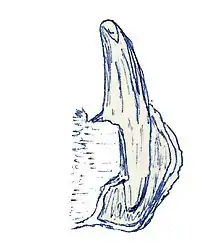Lycorhinus
Lycorhinus is a genus of heterodontosaurid ornithischian dinosaur from the Early Jurassic (Hettangian to Sinemurian ages) strata of the Elliot Formation located in the Cape Province, South Africa.
| Lycorhinus | |
|---|---|
 | |
| Cast of holotype UCRC PVC10 | |
| Scientific classification | |
| Kingdom: | Animalia |
| Phylum: | Chordata |
| Clade: | Dinosauria |
| Order: | †Ornithischia |
| Family: | †Heterodontosauridae |
| Subfamily: | †Heterodontosaurinae |
| Genus: | †Lycorhinus Haughton, 1924 |
| Type species | |
| †Lycorhinus angustidens Haughton, 1924 | |
| Synonyms | |
| |
Description

Lycorhinus, including the remains described by Gow in 1975 as Lanasaurus, is a small (1.2 metres (47 in) in length) herbivorous dinosaur despite the long canines it sported in its jaws.
History of discovery
_(17802167333).jpg.webp)
The fossil material consists of dentaries and maxillae, hence the characters mentioned by the name Lycorhinus angustidens that Sidney H. Haughton attributed to the remains in 1924, where the generic name means "wolf snout", as it was at first misidentified as a cynodont, and the specific descriptor means "constricted tooth".[1]
The holotype, SAM 3606, consists of a mandible found by Dr M. Ricono. Three other species of Lycorhinus have been named. Lycorhinus parvidens was created by Robert Broom and Lycorhinus tucki by Richard Anthony Thulborn in 1970 renaming Heterodontosaurus tucki,[2] but these have failed to find recognition.[3] Lycorhinus consors, named by Thulborn in 1974, was renamed Abrictosaurus by James Hopson in 1975.[4]
Lanasaurus
The type and only species of Lanasaurus is L. scalpridens, described by Christopher Gow in 1975 from the same horizon as Lycorhinus. The generic name is derived from Latin lana, "wool" and Greek saurus, "lizard", and honours Professor Alfred Walter Crompton, nicknamed "Fuzz" because of his woolly hair. The specific name is derived from Latin scalprum, "chisel", and dens, "tooth". It is based on a partial upper jaw bone, the maxilla, holotype BP/1/4244, found in the Upper Elliot Formation of Free State. The teeth show a typical replacement pattern in which during each replacement cycle every third tooth is renewed.[5]
Gow himself in 1990 concluded that the holotype of Lanasaurus was actually a specimen of Lycorhinus angustidens.[6] This has been commonly accepted since.[7][8][9][10]
Classification
L. angustidens is thought to be allied to Heterodontosaurus. Only in 1962 Alfred Walter Crompton recognised it was an ornithischian dinosaur. Thulborn in 1971 created a separate Lycorhinidae[11] but this group was in 1972 equated with Heterodontosauridae by Peter Galton.
References
- S.H. Haughton, 1924, "The fauna and stratigraphy of the Stormberg Series", Annals of the South African Museum 12: 323-497
- R.A. Thulborn, 1970, "The systematic position of the Triassic ornithischian dinosaur Lycorhinus angustidens", Zoological Journal of the Linnean Society 49: 235-245
- Charig, A.J. and Crompton, A.W., 1974, "The alleged synonymy of Lycorhinus and Heterodontosaurus", Annals of the South African Museum 64: 167-89
- J.A. Hopson, 1975, "On the generic separation of the ornithischian dinosaurs Lycorhinus and Heterodontosaurus from the Stormberg Series (Upper Triassic) of South Africa", South African Journal of Science 71: 302-305
- C.E. Gow, 1975, "A new heterodontosaurid from the Redbeds of South Africa showing clear evidence of tooth replacement", Zoological Journal of the Linnean Society 57: 335-339
- Gow, C.E., 1990, "A tooth-bearing maxilla referable to Lycorhinus angustidens Haughton, 1924 (Dinosauria, Ornithischia)", Annals of the South African Museum 99: 367–380
- Norman, D.B., Sues, H.D., Witmer, L.M. and Coria, R.A.. (2004). "Basal Ornithopoda". In D. B. Weishampel, H. Osmólska, and P. Dodson (eds.), The Dinosauria (2nd edition). University of California Press, Berkeley 393-412
- Butler, Richard J.; Galton, Peter M.; Porro, Laura B.; Chiappe, Luis M.; Henderson, D. M.; Erickson, Gregory M. (2010). "Lower limits of ornithischian dinosaur body size inferred from a new Upper Jurassic heterodontosaurid from North America". Proceedings of the Royal Society B. 277 (1680): 375–381. doi:10.1098/rspb.2009.1494. PMC 2842649. PMID 19846460.
- Pol, D.; Rauhut, O.W.M.; Becerra, M. (2011). "A Middle Jurassic heterodontosaurid dinosaur from Patagonia and the evolution of heterodontosaurids". Naturwissenschaften. 98 (5): 369–379. Bibcode:2011NW.....98..369P. doi:10.1007/s00114-011-0780-5. PMID 21452054.
- Richard J. Butler; Jin Liyong; Chen Jun; Pascal Godefroit (2011). "The postcranial osteology and phylogenetic position of the small ornithischian dinosaur Changchunsaurus parvus from the Quantou Formation (Cretaceous: Aptian–Cenomanian) of Jilin Province, north-eastern China". Palaeontology. 54 (3): 667–683. doi:10.1111/j.1475-4983.2011.01046.x.
- R.A. Thulborn, 1971, "Origins and evolution of ornithischian dinosaurs", Nature 234(5324): 75-78
